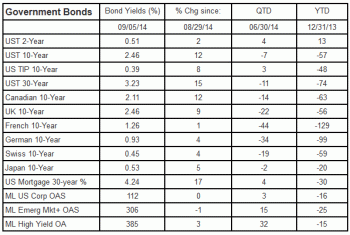John Davidson’s Economic Comments: Week ending Sept. 7
Although the U.S. Employment Report was disappointing, other U.S. releases affirmed that the U.S. recovery was well intact. Elsewhere, the ECB's surprise interest rate deduction showed the concern that the Central Bank had for the Eurozone economies. Geopolitical risks appeared to have eased this week. Most equity markets were higher and most bond markets were lower on the week. The U.S. dollar increased, showing a vote of confidence in the U.S. recovery in the face of the disappointing Payroll Report for August. Commodity prices declined, putting pressure on the natural resource-rich Canadian stock market.
Perspective:
This week the Federal Reserve released its triennial Survey of Consumer Finances, Changes in U.S. Family Finances from 2010 to 2013: Evidence from the Survey of Consumer Finances. "Although aggregate economic performance improved substantially relative to the period between the 2007 and 2010 surveys, the effect on incomes for different types of families was far from uniform." While overall growth in income rose 4% in real terms, the income for families at the bottom of the distribution saw "continued substantial declines." Part of the disparity reversed the trend from the previous period since income distributions narrowed as top income families were more substantially hit by the financial crisis. Families in the middle to upper-middle parts of the income distribution have failed to recover the losses from the previous period. Only families at the very top saw income gains in this survey.
Income inequality has become a political and economic topic of concern for many. Some view the solution as a change to the tax code, to raise additional taxes on the higher income tax payers. That strategy may work at the margin for a short term fix, but does not really offer a viable long-term solution. A Freakonomics study identified education differential as a significant explanatory contributor to income inequality; data from this Fed study supported that claim. The Fed study showed that between 2010 and 2013 median and mean income increased for those with college degrees, but declined for those with and without a high school diploma and with some college education. Furthermore, the medium net worth of those with college degrees increased while the medium new worth of those with only a high school diploma or some college declined; the medium net worth of those with a college degree was about 4 times that of those with some college or only a high school diploma. This suggests that a long term solution of inequality may be better addressed by improving and expanding the educational opportunities for all.
Economic Releases:
The U.S. Employment Report for August was certainly disappointing. Non-farm Payrolls (blue in the chart below) rose 142,000, well below the range of expectations. Net revisions for June and July were minus-28,000. Private Payrolls (red in the chart below), at 134,000, were also below the range of expectations. Manufacturing employment (green in the chart below) was unchanged. The Unemployment Rate did drop a tick to 6.1%, the Average Hourly Earnings did increase +0.2%, and the Average Workweek remained unchanged at 34.5 hours, all as expected. For the week of Aug. 30, Initial Claims for Unemployment benefits rose 4,000 to 302,000.
Yet, other releases showed that the U.S. recovery remained intact. For instance, the August Purchasing Managers Indices were quite robust. The ISM PMI for Manufacturing (blue in the chart) surged two points to 59.0; the ISM PMI for Services rose a point to 59.6. Both were near the high end of the range of expectations and well inside the expansion zone. The Markit PMI for U.S. Manufacturing rose two points to 57.9; the Markit PMI for Services fell a point to 59.5. ISM and Markit each conduct their own surveys of purchasing managers; ISM conducts its surveys for the U.S.; Markit conducts its surveys world wide. In the U.S. most economists focus on the ISM surveys because they have been doing those surveys for the longest time.
Other Economic Releases
The second quarter U.S. Nonfarm productivity increased 2.3% and Unit Labor Costs fell -0.1%, slightly less than originally reported. This was a rebound from the first quarter, for which the Productivity was revised from 2.5% down to -4.55 and the Unit Labor Costs were revised from +0.6% to 11.6%. U.S. Factory Orders for July surged 10.5%, just below consensus. Canada's Ivey PMI slipped a point to 49.1, into the contraction zone.
The European Central Bank surprised the market with a 10 basis point rate cut to 0.05%, a new record low. The ECB also announced that it will begin a purchase program of asset backed securities and covered bonds; details will be disclosed after their October meeting. The Bank of England also met, but kept rates and bond purchases unchanged as the previous month's economic releases have been soft. Similarly, the Bank of Canada left rates unchanged at 1.00% when it met this week.
Second quarter GDP for the EU was flat, up only +0.7% year-over-year the Markit PMI for Manufacturing, Composite and Services each dropped about a point to 50.7, 52.5, and 53.1 respectively. Germany's PMI's dropped similarly to 52.4, 53.7, and 54.9. France's dropped to 46.9, 49.5, and 50.3; only France's Services PMI remained in the expansion zone, above 50. The UK's CIPS PMI for Manufacturing fell three points to 52.5.
Japan's second quarter GDP was revised a tick worse, -1.8% from the previous quarter and flat YOY. China's HSBC PMI Composite and Services PMI's rose to 52.8 and 54.1 respectively.
Equities Markets:
With the exception of the natural resource heavy Canadian markets, equity prices finished higher this week. The European markets had the strongest move in response to the ECB's rate cut. Bond markets fell with rising interest rates.
Bond Markets:
Bond yields rose and credit spreads were mixed on the week. The easing move by the ECB caused European yields to rise less than those in other locations.
Currencies & Commodities:
Demonstrating the robustness of the U.S. economy despite the disappointing employment report, the U.S. dollar rose against the four currencies in the table. Silver remained unchanged, but other Commodity prices declined on the week.
John W. Davidson, CFA, started writing these Comments more than a decade ago as a personal discipline when he was promoted from portfolio manager to chief investment officer and CEO.

Most recently, he was the president of PartnerRe Asset Management Corporation, responsible for the management of PartnerRe's invested assets, which grew from $4 billion to $12 billion during his tenure. After joining PartnerRe in the fall of 2001, he hired the staff, built the trading floor and created the infrastructure to manage both fixed income and equity assets internally. He retired from PartnerRe at the end of 2008 and moved to Maine, where he focused on board work.
He has more than 35 years of industry experience, including positions with investment management responsibility for separate institutional accounts, mutual funds, trusts and insurance assets. Prior to joining PartnerRe, he served as president and chief executive officer of two other investment management companies. For various companies he has held positions as chief investment officer, chief economist, head of fixed income and portfolio manager. As a portfolio manager, Davidson managed and traded U.S. Government Securities as well as futures and options on fixed income instruments.
His real world experience is backed by a strong academic foundation, which includes earning a Master of Business Administration in finance and a Master of Arts in mathematics from Boston College, as well as a Bachelor of Arts, cum laude, in economics from Amherst College. He holds the professional designation of chartered financial analyst.
His experiences and credentials have brought him to the public as a television commentator and conference speaker. In addition to his frequent past appearances on CNBC, CNNfn, Bloomberg TV and Yahoo FinanceVision, he appeared as a special guest on Wall $treet Week with Louis Rukeyser. Reuters, Bloomberg and other business press services have quoted his views on the market. He has taught CFA preparation programs, as well as other courses offered by the Stamford and Boston CFA Societies, and the National Graduate Trust Officers' School.
Davidson is a natural leader in both his professional and personal life, having developed those skills early in his career as a naval officer. He spent three years on active duty, which included a year on the rivers of Vietnam, and 24 years in the Naval Reserve, from which he retired as a captain in 1994.
Davidson is treasurer and board member of the Camden Conference. He is also on the investment committee of the Pen Bay Health Foundation. He serves as an independent trustee for mutual funds.
In his leisure time, he is an active sailor, tennis player and skier. With his wife, Barbara, he renovated a 100+-year-old home in Camden, where they enjoy spending time with their two golden retrievers and having visits from their five children. He can be reached at jwdbond@me.com.






























